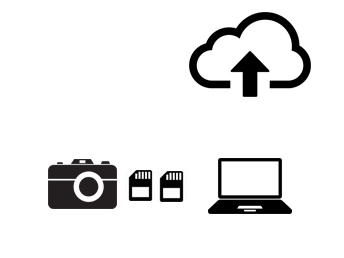There is one simple rule to follow in the management, storage and backing up of digital photographic images;
Always have 2 physical copies and one remote copy.
What this means is that you reduce the impact of a critical failure if a card or hard drive fails. When travelling, and if on a trip that has assessment requirements, you must ensure that you data and images are safe. Reminder, University policy is clear that equipment failure or data loss is not a valid excuse for not submitting assessments.
Option 1: Highest level of protection, lowest Risk
This system ensures that the only time your data is unsafe is during a shoot (unless you have duel cards), or when travelling from a shoot to the hotel. It requires setting up a system, and ensuring that you are disciplined each night.
- Shoot only multiple SD/CF cards. Once full, store the cards in a hard case (protective) and keep in a safe location. If you have a camera with duel cards, you only need to keep the images on one of the cards, cycling out the backup card to keep.
- Each night, transfer the contents of the card(s) onto your laptop computer, sort, rate and reject as appropriate.
- Run a cloud server backup option each night or manually to store the remote copy. This can be on an automatic service (I recommend Back Blaze) or through Drop Box or Google Drive (limits apply)

Option 2: Medium level of protection, some risk
This system is similar to option one, but keeps only physical copies of data (no cloud copy). The ‘remote’ version of the data is entrusted to someone else on the tour. This means your data is not all in the same location (bag), therefore reducing the risk of total loss in the event of theft or you loosing your bag.
- Shoot only multiple SD/CF cards. Once full, store the cards in a hard case (protective) and keep in a safe location. If you have a camera with duel cards, you only need to keep the images on one of the cards, cycling out the backup card to keep.
- Each night, transfer the contents of the card(s) onto your laptop computer, sort, rate and reject as appropriate.
- Backup your computer drive with a portable HD and keep this with someone else on the tour.
Option 3: Low protection (not recommended)
This system does not require a computer, and only keeps physical copies of your data, but in multiple locations.
- Shoot only multiple SD/CF cards. Once full, store the cards in a hard case (protective) and keep in a safe location.
- Store these cards away from the camera equipment and backup once home.